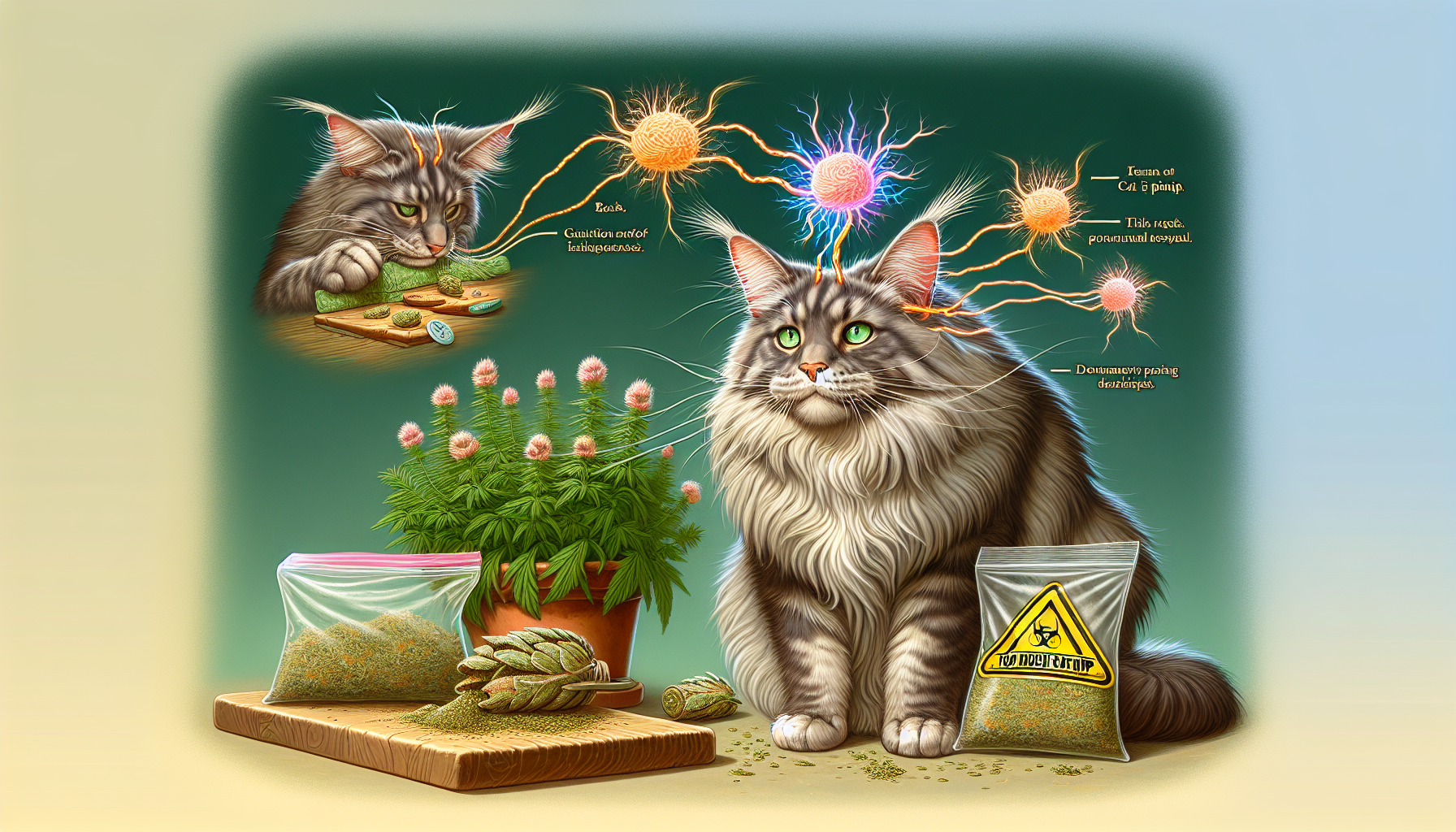Are you curious about how to use catnip for your feline friend? If you’ve ever wondered about the right way to introduce this natural herb to your cat, then this article is for you! Discover the proper usage and benefits of catnip, and learn how it can enhance your cat’s playtime and overall well-being. Find out everything you need to know in our comprehensive guide.

Choosing the Right Catnip
Nepeta Cataria: The Preferred Catnip
When it comes to selecting catnip for your feline friend, one of the most popular choices is Nepeta Cataria, also known as “catnip.” This plant belongs to the mint family and contains a natural compound called nepetalactone, which acts as a stimulant for cats. Nepeta Cataria is favored by many cat owners due to its potency and effectiveness in attracting and engaging cats.
Organic vs. Non-Organic Catnip
When shopping for catnip, you’ll come across both organic and non-organic options. Organic catnip is grown without the use of pesticides or synthetic fertilizers, making it a healthier choice for your cat. Non-organic catnip, on the other hand, may have been exposed to these substances, which could potentially pose a risk to your furry friend. It is always recommended to opt for organic catnip to ensure the safety and well-being of your cat.
Dried Catnip vs. Catnip Sprays
Catnip is available in two primary forms: dried catnip and catnip sprays. Dried catnip typically comes in the form of leaves, flowers, or a mixture of both. It can be used to stuff toys or added to scratching posts to entice and engage your cat. Catnip sprays, on the other hand, are formulated using concentrated catnip oil and can be applied to various surfaces such as scratching posts, toys, or even furniture. Both forms are equally effective, and the choice ultimately depends on your cat’s preferences and your convenience.
Understanding Catnip Sensitivity
Not All Cats Respond to Catnip
It is important to note that not all cats are sensitive to catnip. Research suggests that approximately 50-75% of cats have a genetic predisposition to respond to catnip, while the remaining percentage does not display any reaction. If you’re unsure whether your cat falls into the responsive category, it’s best to introduce catnip cautiously and observe their behavior.
The Genetic Factor: Why Some Cats Are Immune
The sensitivity to catnip is believed to be a genetic trait inherited from the cat’s parents. The specific gene responsible for this sensitivity is thought to create a receptor in the cat’s nose that interacts with the nepetalactone compound found in catnip. Cats without this gene do not possess the receptor, which explains their lack of response to catnip.
Kitten Sensitivity to Catnip
Kittens under the age of six months generally do not exhibit a response to catnip. This is because their sensitivity develops gradually over time. It is recommended to wait until your kitten reaches this age before introducing them to catnip and observing their reaction.
Introducing Catnip to Your Cat
Start with Small Amounts
When introducing catnip to your cat, it’s best to start with small amounts. This allows you to gauge their sensitivity and ensures they don’t become overwhelmed. Sprinkle a small pinch of dried catnip on a surface or apply a small amount of catnip spray to a toy to see how your cat reacts.
Observe Your Cat’s Reaction
Observe your cat closely when they encounter catnip for the first time. Common reactions include rubbing, rolling, meowing, or increased playfulness. Some cats may become more relaxed, while others may become more energetic. Pay attention to their behavior and body language to determine whether they enjoy the experience.
Gradually Increase Catnip Exposure
If your cat responds positively to catnip, you can gradually increase their exposure. Offer catnip-filled toys or place catnip on scratching posts to encourage playtime and mental stimulation. It’s important to note that while catnip is generally safe, excessive exposure may lead to overstimulation or temporary digestive upset. It’s best to strike a balance and ensure your cat’s overall well-being.
Benefits of Catnip for Your Cat
Stress and Anxiety Relief
Catnip has a calming effect on many cats, making it an excellent tool for stress and anxiety relief. Whether your cat is adjusting to a new environment, experiencing separation anxiety, or feeling nervous during vet visits, catnip can help soothe their nerves and create a sense of calm.
Promoting Exercise and Mental Stimulation
Engaging with catnip encourages physical activity and mental stimulation. By providing catnip-filled toys or scratching posts, you can entice your cat to play, chase, and explore. This not only helps maintain their physical health but also prevents boredom and promotes a happy and active lifestyle.
Aiding Digestive Health
Catnip can have a positive impact on your cat’s digestive health. When ingested, it acts as a natural digestive aid, helping to alleviate indigestion, bloating, and constipation. The aromatic properties of catnip can also stimulate appetite in cats who may be reluctant to eat.
Using Catnip Toys and Accessories
Choosing Catnip Filled Toys
Catnip toys come in various shapes and sizes, offering a wide range of options for your cat’s entertainment. From plush mice to interactive puzzle toys, there is something to cater to every feline’s preferences. When purchasing catnip toys, ensure they are made from safe and durable materials that withstand your cat’s playfulness.
Catnip Scratchers and Climbers
Catnip scratchers and climbers are excellent additions to your cat’s play area. These products often come with scratching surfaces infused with catnip, which helps attract your cat to use them instead of your furniture. Providing them with an enticing scratching alternative can save your furniture from unnecessary damage.
Catnip Sprays for Furniture Training
If you’re looking to deter your cat from scratching or marking specific furniture, catnip sprays can be an effective training tool. By applying catnip spray to a scratching post or designated area, you can redirect your cat’s attention and encourage them to use those areas instead. Always ensure that the spray is safe for furniture and does not cause any damage or staining.
Refreshing Catnip Effectiveness
Replacing Old Catnip Toys
Over time, your cat’s favorite catnip-filled toys may lose their potency. If you notice a decline in your cat’s interest or response, it may be time to replace the old toys with new ones. By providing fresh catnip toys, you can continue to engage and entertain your cat effectively.
Reviving Dried Catnip
If you have dried catnip that has lost its potency, don’t worry! You can revive it using a simple trick. Place the dried catnip in an airtight container, add a few drops of catnip spray or essential oil, and shake it gently. This will help restore the scent and make the catnip enticing for your cat once again.
Reapplying Catnip Spray
If you’ve used catnip spray on a particular area or toy, its effectiveness may diminish over time. To refresh the scent, simply reapply the catnip spray. This will reignite your cat’s interest and encourage them to continue using the designated areas or toys.
Safety Precautions with Catnip
Don’t Overindulge Your Cat
While catnip is generally safe, it’s important not to overindulge your cat. Excessive exposure can lead to overstimulation, restlessness, or temporary digestive issues. To ensure your cat’s well-being, moderate their access to catnip and provide other forms of enrichment alongside it.
Avoid Excessive Catnip Use
Using catnip excessively may desensitize your cat and diminish its overall effectiveness. It’s best to use catnip sparingly and provide breaks between each session to maintain your cat’s sensitivity and interest.
Consulting a Veterinarian
If you have any concerns or questions regarding the use of catnip with your cat, it’s always a good idea to consult with your veterinarian. They can provide personalized advice based on your cat’s specific needs and health condition.
Alternatives to Catnip
Valerian Root
Valerian root is a herb that can have similar effects to catnip in some cats. It has a calming effect and may help relieve anxiety and stress. However, it’s important to note that not all cats respond to valerian root, so it may not be a suitable alternative for every feline.
Silver Vine
Silver vine, also known as Actinidia polygama, is another natural alternative to catnip. It contains similar compounds to catnip, including nepetalactone, and can induce similar reactions in cats. If your cat doesn’t respond to catnip, silver vine might be an excellent alternative to explore.
Honeysuckle Sticks
Honeysuckle sticks are a popular alternative for cats that either don’t respond to catnip or prefer a different scent. The wood of the honeysuckle plant produces a fragrance that some cats find appealing and stimulating. Offering honeysuckle sticks can provide your cat with a safe and enjoyable alternative to catnip.
Catnip Dos and Don’ts
Do Monitor Your Cat’s Behavior
It is crucial to monitor your cat’s behavior when using catnip. While most cats enjoy catnip without any issues, some may become hyperactive or exhibit aggressive behavior. If you notice any negative changes, it’s best to discontinue use and consult with a veterinarian.
Don’t Use Catnip on Aggressive Cats
If you have an aggressive cat, it’s generally recommended to avoid using catnip. Catnip can increase aggression in certain cats, and its use may not be suitable for them. Instead, focus on behavior modification techniques and consult with a professional behaviorist to address your cat’s aggression.
Do Experiment with Different Catnip Products
Every cat is unique, and their preferences may vary. Experimenting with different catnip products, such as toys, sprays, or even different varieties of catnip, can help you find what your cat enjoys the most. Don’t be afraid to try various options to provide the best experience for your furry friend.
Conclusion
Catnip can be a valuable tool in enriching your cat’s life, providing stress relief, exercise, and mental stimulation. By understanding the different types of catnip, your cat’s sensitivity, and how to introduce it properly, you can ensure a positive and rewarding experience for both you and your feline companion. Remember to use catnip in moderation, monitor your cat’s behavior, and consult with a veterinarian when necessary. With the right approach, catnip can be a wonderful addition to your cat’s world of fun and enjoyment.
